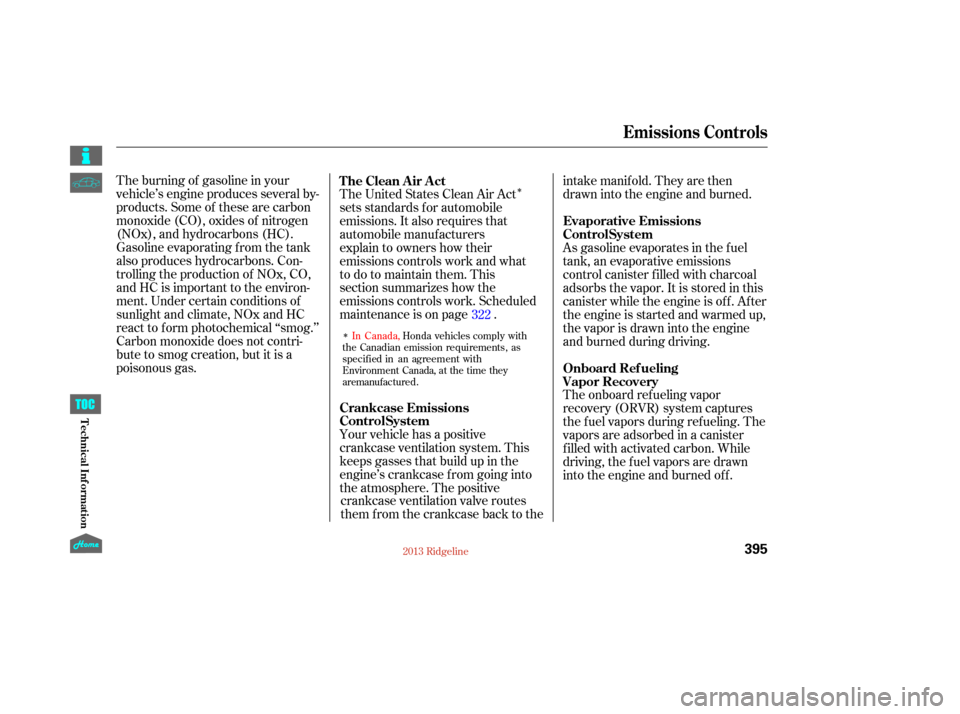Page 393 of 422

The tires on your vehicle meet all
U.S. Federal Saf ety Requirements.
All tires are also graded f or
treadwear, traction, and temperature
perf ormance according to
Department of Transportation
(DOT) standards. The f ollowing
explains these gradings.The treadwear grade is a compara-
tive rating based on the wear rate of
the tire when tested under controlled
conditions on a specif ied government
test course. For example, a tire
graded 150 would wear one and one-
half (1 1/2) times as well on the
government course as a tire graded
100. The relative perf ormance of
tires depends upon the actual condi-
tions of their use, however, and may
depart signif icantly f rom the norm
due to variations in driving habits,
service practices and dif f erences in
road characteristics and climate.The traction grades, f rom highest to
lowest, are AA, A, B, and C. Those
grades represent the tire’s ability to
stop on wet pavement as measured
under controlled conditions on
specif ied government test surf aces
of asphalt and concrete. A tire
marked C may have poor traction
perf ormance.
Warning: The traction grade
assignedtothistireisbasedon
straight-ahead braking traction tests,
and does not include acceleration,
cornering, hydroplaning, or peak
traction characteristics.
Quality grades can be f ound where
applicable on the tire sidewall
between tread shoulder and
maximum section width. For
example:
All passenger car tires must conf orm
to Federal Saf ety Requirements in
addition to these grades. Unif orm T ire Quality Grading T readwear
T raction
T readwear 200
Traction AA
Temperature A
DOT Tire Quality Grading (U.S. Vehicles)
388
12/08/09 16:50:27 31SJC670_395
Technical Inf ormation
Page 400 of 422

�ÎThe burning of gasoline in your
vehicle’s engine produces several by-
products. Some of these are carbon
monoxide (CO), oxides of nitrogen
(NOx), and hydrocarbons (HC).
Gasoline evaporating f rom the tank
also produces hydrocarbons. Con-
trolling the production of NOx, CO,
and HC is important to the environ-
ment. Under certain conditions of
sunlight and climate, NOx and HC
react to f orm photochemical ‘‘smog.’’
Carbon monoxide does not contri-
bute to smog creation, but it is a
poisonous gas.The United States Clean Air Act
sets standards for automobile
emissions. It also requires that
automobile manufacturers
explain to owners how their
emissions controls work and what
to do to maintain them. This
section summarizes how the
emissions controls work. Scheduled
maintenance is on page
.
Your vehicle has a positive
crankcase ventilation system. This
keeps gasses that build up in the
engine’s crankcase f rom going into
the atmosphere. The positive crankcase ventilation valve routes
them from the crankcase back to the intake manif old. They are then
drawn into the engine and burned.
As gasoline evaporates in the f uel
tank, an evaporative emissions
control canister f illed with charcoal
adsorbs the vapor. It is stored in this
canister while the engine is of f . Af ter
the engine is started and warmed up,
the vapor is drawn into the engine
and burned during driving.
The onboard ref ueling vapor
recovery (ORVR) system captures
the f uel vapors during ref ueling. The
vapors are adsorbed in a canister
f illed with activated carbon. While
driving, the f uel vapors are drawn
into the engine and burned of f .
322
The Clean Air Act
Crankcase Emissions
Control Evaporative Emissions
Control System
Onboard Ref ueling
Vapor Recovery
Emissions Cont rols
395
12/08/09 16:51:17 31SJC670_402
Technical Inf ormation
�ÎIn Canada,
Honda vehicles comply with
the Canadian emission requirements , as
specified in an agreement with
Environment Canada, at the time they
are manufactured.
System
Page 412 of 422

Bulb Replacement..........................
Back-up Lights .337
..............................
Brake Lights .337
.................................
Bed Lights .340
.........
Daytime Running Lights . 336
.................................
Fog Lights .336
Front Turn Signal/Parking/ .......................
Hazard Lights .335
.................................
Headlights .333
.........
High-mount Brake Light . 338
.................
License Plate Lights . 339
Rear Bulbs (Brake/Taillights, Turn Signal/Hazard Lights, ................
Back-up Lights) . 337
............................
Specif ications .387
......................
Bulbs, Halogen .333, 336
...................
Capacities Chart . 386, 387
.............
Carbon Monoxide Hazard . 55
.........................
Cargo Hooks .118, 137
.............................
Carrying Cargo .257
.............
CAUTION, Explanation of . iv
.........................................
CD Care .198
..........................
CD Changer .181, 189 CD Player/Changer Error
...................................
Messages .202
.......................................
CD Player .175
........................
Certif ication Label .384
....................................
Chains, tire .351
Change Oil ........................................
How to .325
......................................
When to .311
....................
Changing a Flat Tire .359
...
Charging System Indicator . 63, 372
............
Checklist, Bef ore Driving . 267
................
Childproof Door Locks . 104
.....................................
Child Saf ety .34
..............................
Booster Seats .52
...................................
Child Seats .41
.....
Important Saf ety Reminders . 34
..........................................
Inf ants .39
..........................
Larger Children .51
.........................................
LATCH .43
......................
Risks with Airbags .35
.............................
Small Children .40
....................................
Tether .43, 48
.........
Where Should a Child Sit? . 35
.......................................
Child Seats .41
.........................................
LATCH .43
..........
Tether Anchorage Points . 48...............
Climate Control System . 152
..............................................
Clock .207
....................................
Coat Hooks .138
.....................
Code, Audio System .205
..................
CO in the Exhaust . 55, 395
......................
Compact Spare Tire .358
.................
Console Compartment . 136
.................
Consumer Inf ormation . 402
.............
Controls, Instruments and . 59
Coolant ........................................
Adding .327
....................................
Checking .251
.........................
Proper Solution .327
...................
Temperature Gauge . 76
..............................
Courtesy Light .143
Crankcase Emissions Control ........................................
System .395
Cruise Control .......................................
Indicator .67
...................................
Operation .210
...................................
Cup Holders .137
.........................
Customer Service .402
...............
DANGER, Explanation of . iv
C
D
II
12/08/09 16:52:41 31SJC670_415
IndexA B C D E F G H I J K L M N O P Q R S T U V W X Y Z
Page:
< prev 1-8 9-16 17-24